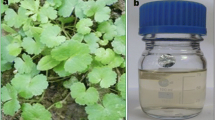Abstract
Biosynthesis of copper, zero-valent iron (ZVI), and silver nanoparticles using leaf extract of Dodonaea viscosa has been investigated in this report. There are no additional surfactants/polymers used as capping or reducing agents for these syntheses. The synthesized nanoparticles were characterized by UV–Vis spectroscopy, X-ray diffraction, atomic force microscopy, and high-resolution transmission electron microscopy. The phase analysis was performed using selected area electron diffraction. The pH dependence of surface plasmon resonance and subsequent size variation has been determined. The synthesized nanoparticles showed spherical morphology and the average size of 29, 27, and 16 nm for Cu, ZVI, and Ag nanoparticles, respectively. Finally, biosynthesized Cu, ZVI, and Ag nanoparticles were tested against human pathogens viz. Gram-negative Escherichia coli, Klebsiella pneumonia, Pseudomonas fluorescens and Gram-positive Staphylococcus aureus and Bacillus subtilis, and showed good antimicrobial activity.








Similar content being viewed by others
References
Chen DH, Hsieh CH (2002) Synthesis of nickel nanoparticles in aqueous cationic surfactant solutions. J Mater Chem 12:2412–2415
Daniel SCGK, Nehru K, Sivakumar M (2012) Rapid biosynthesis of silver nanoparticles using Eichornia crassipes and its antibacterial activity. Curr Nanosci 8(1):125–129
Diao M, Yao M (2009) Use of zero-valent iron nanoparticles in inactivating microbes water research 43:5243–5251
Dubey SP, Lahtinen M, Sillanpaa M (2010) Green synthesis and characterizations of silver and gold nanoparticles using leaf extract of Rosa rugosa. Colloid Surf A 364:34–41
Gericke M, Pinches A (2006) Biological synthesis of metal nanoparticles. Hydrometallurgy 83:132–140
Kleemann W (1993) Random-field induced antiferromagnetic, ferromagnetic and structural domain states. Int J Mod Phys B 7:2469
Lee C, Kim JY, Lee WI, Nelson KL, Yoon J, Sedlak DL (2008) Bactericidal effect of zero-valent iron nanoparticles on Escherichia coli. Environ Sci Technol 42:4927–4933
Linga Rao M, Savithramma N, Rukmini K, Suvarnalatha Devi P (2011) Antimicrobial activity of silver nanoparticles synthesized by using medicinal plants. Int J ChemTech Res 3(3):1394–1402
Mandal D, Bolander ME, Mukhopadhyay D, Sarkar G, Mukherjee P (2006) The use of microorganisms for the formation of metal nanoparticles and their application. Appl Microbiol Biotechnol 69:485–492
Mohanpuria P, Rana NK, Yadav SK (2008) Biosynthesis of nanoparticles: technological concepts and future applications. J Nanopart Res 10:507–517
Prema P, Selvarani M (2012) Inactivation of bacteria using chemically fabricated zero valent Iron nanoparticles. Int J Pharm Sci 03(01):37–41
Ramyadevi J, Jeyasubramanian K, Marikani A, Rajakumar G, Rahuman A (2012) Synthesis and antimicrobial activity of copper nanoparticles. Mater Lett 71:114–116
Ruparelia JP, Chatterjee AK, Duttagupta SP, Mukherji S (2008) Strain specificity in antimicrobial activity of silver and copper nanoparticles. Acta Biomater 4:707–716
Ryan JN, Harvey RW, Metge D, Elimelech M, Navigato T, Pieper AP (2002) Field and laboratory investigations of inactivation of viruses (PRD1 and MS-2) attached to iron oxide-coated quartz sand. Environ Sci Technol 36:2403–2413
Sastry M, Ahmad A, Khan MI, Kumar R (2003) Biosynthesis of metal nanoparticles using fungi and actinomycete. Curr Sci 85:162–170
Sastry M, Ahmad A, Khan MI, Kumar R (2004) Microbial nanoparticle production. In: Niemeyer CM, Mirkin CA (eds) Nanobiotechnology. Wiley, Weinheim, pp 126–135
Tripathy A, Raichur AM, Chandrasekaran N, Prathna TC, Mukherjee A (2010) Process variables in biomimetic synthesis of silver nanoparticles by aqueous extract of Azadirachta indica (Neem) leaves. J Nanopart Res 12:237–246
Vaseem M, Lee KM, Kim DY, Hahn Y-B (2011) Parametric study of cost-effective synthesis of crystalline copper nanoparticles and their crystallographic characterization. Mater Chem Phys 125:334–341
Veerasamy R, Xin TZ, Gunasekaran S, Xiang TFW, Yang EFC, Jeyakumar N, Dhanaraj SA (2011) Biosynthesis of silver nanoparticles using mangosteen leaf extract and evaluation of their antimicrobial activities. J Saudi Chem Soc 15:113–120
Venkatesh S, Reddy YSR, Ramesh M, Swamy MM, Mahadevan N, Suresh B (2008) Pharmacognostical studies on Dodonaea viscosa. Afr J Pharm Pharmacol 2(4):083–088
Wen J, Li J, Liu S, Chen QY (2011) Preparation of copper nanoparticles in a water/oleic acid mixed solvent via two-step reduction method. Colloids Surf A 373:329–335
Wiley BJ, Im SH, Li Z-Y, McLellan J, Siekkinen A, Younan Xia J (2006) Maneuvering the surface plasmon resonance of silver nanostructures through shape-controlled synthesis. Phys Chem B 110:15666–15675
Wu SH, Chen D-H (2004) Synthesis of high-concentration Cu nanoparticles in aqueous CTAB solutions. J Colloids Interface Sci 273:165–169
Wu C, Brian Mosher P, Zeng TF (2006) One-step green route to narrowly dispersed copper nanocrystals. J Nanopart Res 8:965–969
Yoon KY, Byeon JH, Park JH, Hwang J (2007) Susceptibility constants of Escherichia coli and Bacillus subtilis to silver and copper nanoparticles. Sci Total Environ 373:572–575
Author information
Authors and Affiliations
Corresponding author
Additional information
S. C. G. Kiruba Daniel and G. Vinothini contributed equally to this study.
Electronic supplementary material
Below is the link to the electronic supplementary material.
Fig. S1
UV-Visible spectra of copper nanoparticles synthesized with different amounts of Dodonaea viscosa leaf extract at pH 10 (A) 1 ml (B) 2 ml (C) 3 ml (D) 4 ml (E) 5 ml
Fig. S2
UV- Visible spectra of Zero Valent Iron nanoparticles synthesized from 10 mM FeCl3 with different amount of Dodonaea viscosa extract at room temperature
Fig. S3
UV-Visible spectra of Ag Nps synthesized using different amounts of Dodonaea viscosa leaf extract after 5 h of reaction (A) 250 µl (B) 500 µl (C) 1 ml (D) 2 ml extract with 1 mM AgNO3
Fig. S4
UV-Visible spectra of copper nanoparticles synthesized using 5 ml of D. viscosa extract at different pH (1) pH 6, (2) pH 8 and (3) pH 10 with 5 ml 1 mM CuCl2 at 50˚C
Fig. S5
UV-Visible spectra of Ag Nps synthesized using 2 ml of D. viscosa leaf extract with 1 mM AgNO3 at different pH from 2 to 10
Fig. S6
HRTEM images of Cu NP (A&B), ZVI NP (C&D) and Ag NP (E&F) taken at 10 and 50 nm as scale. (DOCX 6181 kb)
Rights and permissions
About this article
Cite this article
Kiruba Daniel, S.C.G., Vinothini, G., Subramanian, N. et al. Biosynthesis of Cu, ZVI, and Ag nanoparticles using Dodonaea viscosa extract for antibacterial activity against human pathogens. J Nanopart Res 15, 1319 (2013). https://doi.org/10.1007/s11051-012-1319-1
Received:
Accepted:
Published:
DOI: https://doi.org/10.1007/s11051-012-1319-1




